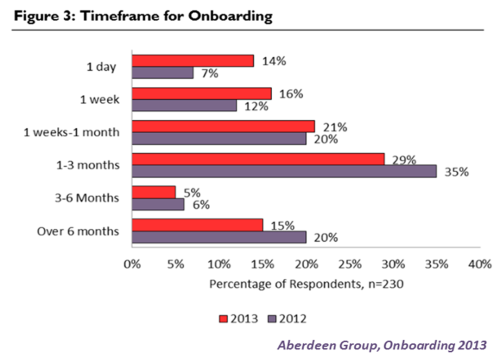As HR and other leaders grapple with high turnover rates among the Gen Y/Millennial cohort (see last week’s post here), all kinds of issues get raised.
Is the turnover due to “special” characteristics inherent in Gen Y? Is the turnover due to lack of education and training opportunities? Naivete on the part of Millennials – the world of work doesn’t match their expectations? Could a lack of thoughtful onboarding play a part?
The Aberdeen Group published Onboarding 2013: A New Look at New Hires last month and author Madeline Laurano provides data that might help organizations become more effective in retaining the youngest of their workforce.
A new focus on productivity
First of all, Aberdeen reports that only 37 percent of employers have invested in a formal onboarding program for longer than two years. Surveys report that it’s difficult to quantify the ROI on formal onboarding programs so “basic orientation” activities are used in substitution.
Socializing new hires into the organization’s culture is popular, but hard to measure. And so, “onboarding programs have fallen short and become little more than a transition from recruitment to employee development.” Interesting.
But attention is starting to be paid and — surprise! — it’s all about productivity.
One of the quickest routes to ROI is the improvement of productivity and that’s something organizations can measure. Other drivers for looking at new ways to onboard new hires include improving employee engagement, reducing turnover and improving new hire assimilation.
But, as the graph below shows, there’s lots of opportunity to make onboarding programs more robust, strategic and productive by spending more time.
Strategies for better onboarding
And it doesn’t have to be rocket science! The kinds of strategies being used to drive stronger onboarding programs include the following:
- Creating new hire checklists;
- Introducing new hires to the go-to people;
- Providing forms to new hires before Day One;
- Ensuring compliance on all new hire forms;
- Creating peer networking opportunities/events.
But the real key appears to be creating a bridge from the candidate experience to learning/development and performance management. After offer acceptance, Best-in-Class employers are more than twice as likely than all other organizations “to integrate data from onboarding into performance management, providing key stakeholders with development plans of new hires and to tie the source of a candidate to their performance as an employee.”
But still, only 26 percent of Best-in-Class employers enroll new hires in learning and development programs compared to 11 percent of all others. Hmmm….
Laurano concludes the report with recommended actions for employers in Best-in-Class, Average and Laggard categories. For the Average and Laggard categories they are not rocket science. For the Best-in-Class category, a little rocket science might be involved.
Laggard steps to onboarding success
- Establish a clear owner;
- Provide strong visibility;
- Extend the onboarding process.
Industry average steps in onboarding success
- Align onboarding with learning initiatives;
- Define metrics in advance;
- Invest in onboarding technology.
Best-in-class steps to onboarding success
- Consider gamification;
- Include cross-boarding;
- Balance tactical and strategic element.
Think about these as you and other leaders in your organization wrestle with the high turnover rate in your Gen Y/Millennial employees. And take a look at this report.
Aberdeen Group reports are very easily consumed. They’re written in normal English and have an easy to understand structure. Even if you can’t spend real money to make your onboarding program more productive, you can certainly get smarter about what works and make some adjustments based on data to improve your outcomes.
That’s the whole point of research, right?
This originally appeared on China Gorman’s blog at ChinaGorman.com.
